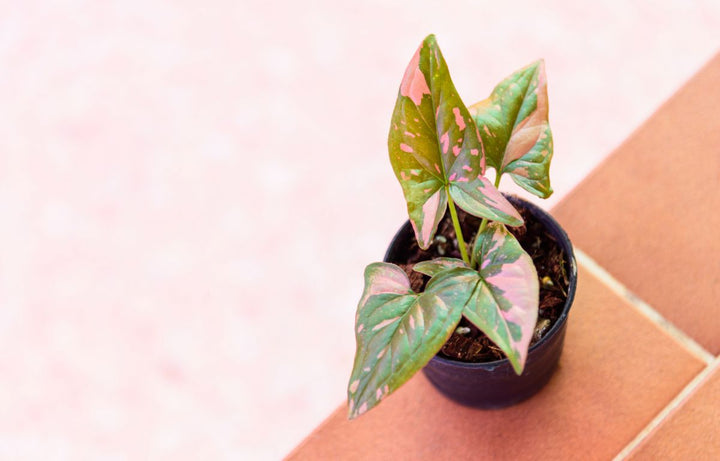
Plant Profile: Syngonium
Plant Profile: Syngonium
Syngonium plants, also known as arrowhead plants or arrowhead vines, with their striking foliage and easy-care nature, have gained popularity among indoor gardeners. These versatile plants offer a fast array of colors, sizes, and patterns, making them a perfect choice for both novice and experienced plant collectors alike.

Syngonium plants belong to the Araceae family, perhaps more known for its low-light tolerant cousin the Peace Lily. Syngoniums are native to tropical regions of Latin America, including Mexico, Brazil, and Bolivia. They are commonly found in rainforests, where they thrive in warm, humid conditions with dappled sunlight. They were likely exported worldwide during the period of botanical exploration and trade that began in the 18th century but gained significant popularity as houseplants in the latter half of the 20th century.
Varieties of Syngonium:
Syngonium plants come in a range of varieties, each with its own unique leaf shapes, colors, and patterns. Some popular varieties include:
- Syngonium podophyllum: This is the most common variety, featuring arrow-shaped leaves with various shades of green, cream, and white. It's a great choice for beginners due to its easy-care nature.
- Syngonium 'Pink Splash': Known for its vibrant pink speckled leaves, this variety adds a pop of color to any indoor space.
- Syngonium 'White Butterfly': With its white and green marbled leaves, this variety adds an elegant touch to indoor gardens.
- Syngonium 'Neon Robusta': As the name suggests, this variety boasts bright neon-green leaves, making it a standout addition to any collection.
- Syngonium 'Maria Allusion': Featuring silver-green leaves with pink veins, this variety adds a touch of sophistication to indoor settings.
- Syngonium podophyllum 'Confetti': Syngonium podophyllum 'Confetti' features small arrowhead-shaped leaves with green, pink, and cream colors, ideal for compact indoor spaces.

Care and Maintenance:
Syngonium plants are considered low-maintenance, making them ideal for both experienced and novice indoor gardeners.
Light: Syngonium plants prefer bright, indirect light but can tolerate lower light conditions. Avoid exposing them to direct sunlight, as it may scorch their leaves. Keep in mind that variegated or Syngonium varieties with less green pigments may require more sunlight per day. The pale or white patches reduce their chlorophyll content and produce less energy needed to grow.
Watering: Keep the soil evenly moist during the growing season (spring and summer) but allow the top inch of soil to dry out between waterings to prevent waterlogging the soil. In winter, reduce watering frequency and only water when needed.
Humidity: Syngonium plants thrive in high-humidity environments. You can increase humidity by misting the leaves regularly or placing the plant on a humidity tray filled with water and pebbles.
Temperature: Maintain temperatures between 15-27°C. Avoid exposing the plant to cold drafts or sudden temperature fluctuations.
Fertilization: Feed your Syngonium with a balanced liquid fertilizer diluted to half-strength every 4-6 weeks during the growing season.
Pruning: Regularly prune your Syngonium to encourage bushier growth and remove any yellowing or damaged leaves. For areas with very limited space, Syngoniums can be pruned quite aggressively before affecting the plant’s health.
Propagation:
Propagating Syngonium plants is relatively easy and straightforward. This can be done through several methods:
Stem Cuttings: Take a cutting from a healthy stem with at least a few leaves and nodes. Place the cutting in water or directly into moist potting soil, and it will develop roots over time.
Division: Divide mature plants into smaller sections, ensuring each division has roots attached. Replant the divisions in separate pots with well-draining soil.
Rhizome Division: Separate rhizomes (underground stems) from the parent plant and plant them in individual pots with soil.

Common Problems and Solutions:
Despite their resilience, Syngonium plants may encounter some issues. Here are a few common problems and their solutions:
Yellowing leaves: This could be a sign of overwatering, underwatering, or poor drainage. Adjust your watering routine accordingly and ensure the plant's pot has proper drainage holes.
Brown leaf tips: Brown tips on Syngonium leaves are usually caused by low humidity or salt buildup in the soil. Increase humidity levels and flush the soil occasionally with distilled water to remove excess salts.
Pests: Like most indoor plants, Syngonium plants are susceptible to pests such as spider mites, aphids, and mealybugs. Keep an eye out for any signs of infestation and treat them promptly with insecticidal soap or neem oil.
Wilting: Wilting can be a sign of underwatering or root rot due to overwatering. Check the soil moisture level and adjust your watering routine accordingly. If root rot is suspected, remove the plant from its pot, trim away any affected roots, and repot it in fresh, well-draining soil.
Flowering: It is relatively rare for Syngonium plants to flower when grown indoors. When they do bloom, their flowers are typically small, inconspicuous, and have a spadix (a central, upright structure) surrounded by a spathe (a modified leaf) typical of the Araceae family. To encourage Syngoniums to flower provide bright, indirect light, maintain warmth and humidity, sparingly fertilize, keep the soil moist, and be patient. Provide ample time outdoors during sunny days but be careful to not sit the plant in direct sunlight.
There is a reason Syngonium plants have been a favorite over the years. With such diversity and aesthetic appeal, you can collect multiples of the same variety and not one plant will look entirely the same as another! With generalized maintenance and care requirements, this plant is suitable for gardeners of all experiences and suited to almost any décor and space.
Keen to learn about Calatheas?
